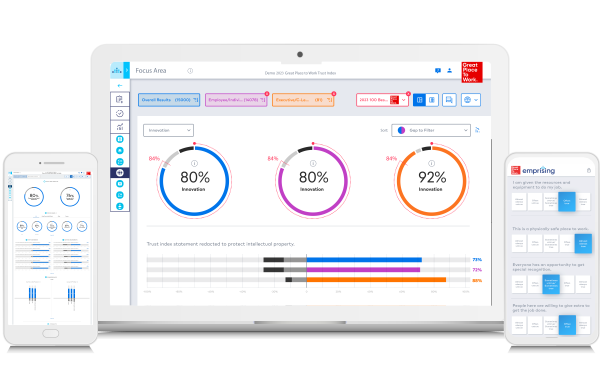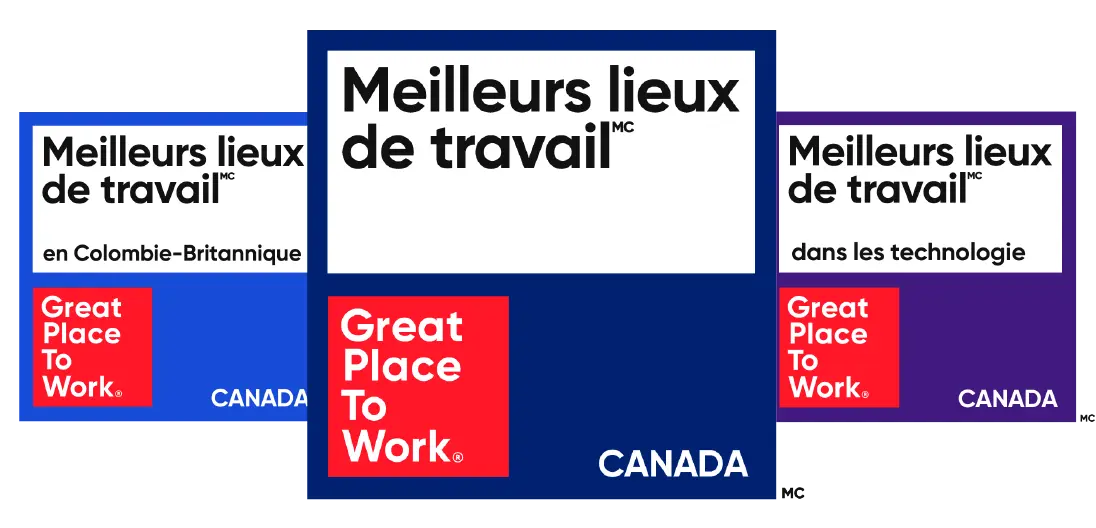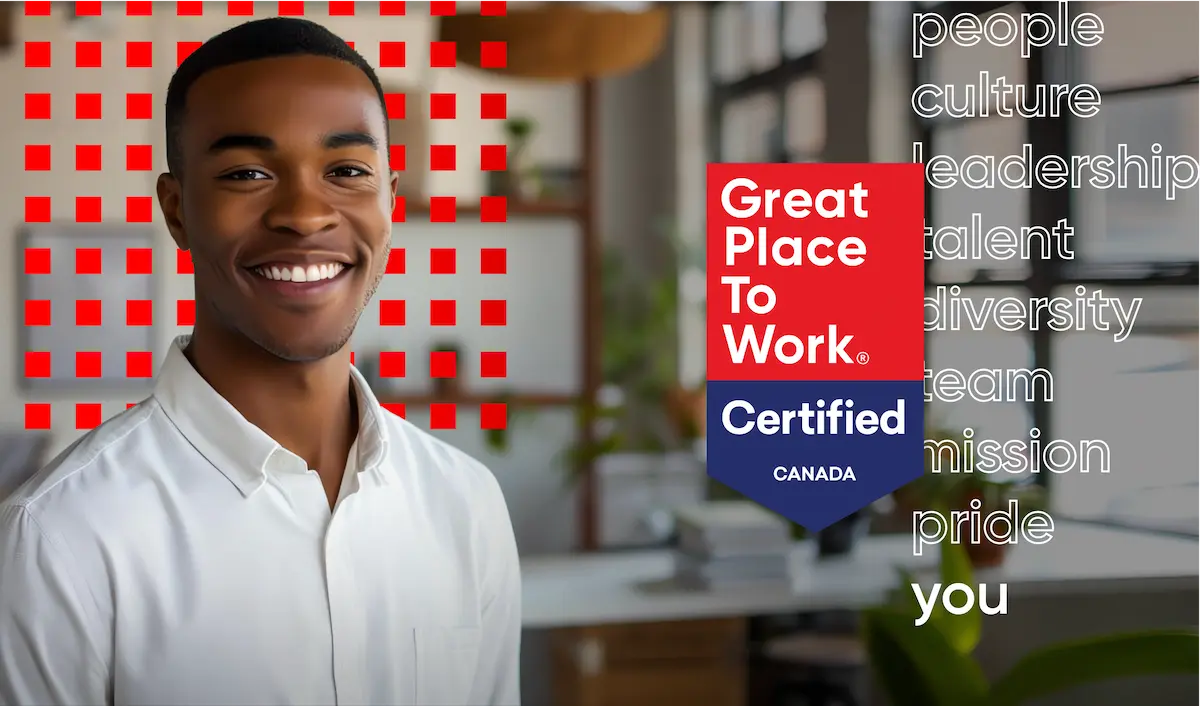
Feeling respected. Having a sense of belonging. Feeling valued for who we are as individuals. These are the things that elevate our sense of inclusion and lead to us being able to do our best work. They are universal to the human experience – everyone wants to feel supported and included, trusted and appreciated. As leaders we can make a difference in all our peoples’ lives by making inclusion an integral part of our workplace culture and accepting nothing less from our colleagues, our peers, our customers, and all of our stakeholders.
This level of commitment to an inclusive workplace is exactly what we see at the Best Workplaces™ for Inclusion and their employees are the ones who are noticing. 97 percent of their people agree, “People are treated fairly regardless of their age, race or ethnicity, gender, or sexual orientation.” This assurance of fair treatment cascades to many other elements of workplace culture and leads to employees’ resounding agreement with statements like the following:
| I am treated as a full member here regardless of my position: | 93% |
| I can be myself around here. | 93% |
| People avoid politicking and backstabbing as ways to get things done. | 91% |
| Everyone has an opportunity to get special recognition. | 89% |
| Managers avoid playing favorites. | 87% |
| Promotions go to those who best deserve them. | 85% |
How can you achieve similar responses from your people? And what are some of the best practices for creating an inclusive workplace? Let’s look at what some of the organizations on our list are doing to ensure their people feel included.
A large element of building and supporting inclusion is making sure your workforce reflects the larger community. When you bring together different backgrounds and perspectives you are better prepared to innovate and meet the challenges of our increasingly global marketplace. As part of this, a diverse workplace full of different types of people is easy to spot as is one that is overly homogenous. To be more inclusive, diversifying your workplace is a great place to start.
At Genesys they are proactive with their diversity goals and they measure their progress by tracking employee demographic data by race, ethnicity and gender as a percentage of the overall employee base and against leadership representation. To increase the accuracy of their data and capture a more complete portrait of their workforce diversity, employees are invited to participate in a voluntary self-identification survey. Through the survey, employees can self-identify against various demographic categories including gender, race and ethnicity as well as sexual orientation, and disability status.
Using this demographic information they address representation challenges through hiring and recruitment practices that focus on inclusion. This includes:
- Competency-based hiring – by focusing on competency you can eliminate sources of bias during the interview process. The goal is to increase objectivity and hire candidates based on experience, capabilities and skill alone.
- Unconscious bias training – providing training on unconscious bias helps people understand where bias comes from and become aware of their own biases in order to create new approaches and patterns that promote inclusion.
- Mitigating bias in recruitment – leveraging technology to promote the use of inclusive language in posted job descriptions helps equally attract male, female and underrepresented candidates in an inclusive, professional way.
As organizations work to expand their diversity, the reality of a worker shortage is making it an absolute necessity in order to find qualified people. Organizations committed to inclusion are actively partnering with recruitment firms focused on finding placements for strong candidates looking to immigrate to Canada. To support these new workers the Best Workplaces are dedicating time and resources to not only helping their people orient to a new company, but to a new country as well.
At Vendasta 20% of their development team in Saskatoon has immigrated from countries like Brazil, India and more. Their People Operations team has helped some of the new hires who moved from other countries to set up home with their families in Saskatoon. The team works with them on everything from booking flights and accommodations, to assisting with finding a rental property, and schools for their children.
Wave Financial provides full and extensive support through the immigration process for many of their people who have immigrated from places like Nigeria, Pakistan, Brazil, and more recently, Hong Kong, India, and Sweden. They have a very comprehensive "Welcome to Canada" package that provides details for how to enroll in OHIP, find a family doctor, rent or buy a home, get around the city, find great places to eat, enrol kids in school and of course, how to survive winter.
These types of programs send a strong message to the immigrating employees and the whole organization that helping new people feel welcomed is important. Remember, it’s not just about attracting a diverse population but helping them integrate and feel their unique background is valued and valuable.
As a best practice, it’s important too to look at inclusion through a broad lens. Often people equate diversity with gender, underrepresented minorities and people who identify as part of the LGBTQ community. And while these are key populations to address when thinking about inclusion, it leaves out other groups of workers who may feel their voices aren’t being heard or considered equally. People working at locations outside of a large headquarters are often treated differently than HQ staff. At organizations that work under a franchise model there is often a disparity between how corporate staff are treated versus franchisee staff. The recent explosion of remote work has brought to light the plight of the remote worker and their feelings of isolation and not being regarded as full-fledged members of the team.
Other examples include employees with age and generational differences, employees who need flexible time off to care for children, parents and other dependents, those with disabilities related to mental health or neurodiversity, and people from different socioeconomic backgrounds and even political affiliations. To be truly inclusive leaders must actively commit to ensuring parity of experience and equitable treatment for all workers. This means creating systems that promote the exchange of ideas, that encourage all voices to be heard, and that ensure different perspectives can be voiced and are respected.
Sun life has taken an interesting approach to developing an inclusive workplace for those who work remotely. These workers are guaranteed an equitable level of participation and interaction wherever they choose to work. Sunlife’s focus is on building an inclusive experience to support a hybrid workforce, no matter what space is used. Examples of this include new Presentation Rooms, where in-office seats are oriented toward a screen featuring virtually located colleagues; and a shift away from using tactile/physical collaboration tools, to ensure virtual participants aren’t sidelined.
At Echelon their focus on inclusion and belonging includes a religious and cultural observances calendar. This calendar highlights a plethora of religious and cultural observances, holidays, traditions, all of which are highlighted and celebrated through their various corporate communication platforms. Through this mechanism they seek to acknowledge and celebrate all persons of all backgrounds and cultures.
Having a diverse group of employees within their restaurants has allowed Franchise Management Inc to be more thought provoking and open to trying new ideas which gives them higher employee engagement. They offer flexible work schedules to allow employees to work around their unique needs. As examples, at their support center they have a dedicated prayer room and offer even more flexibility during the Ramadan period.
Finally, a key part of the inclusion journey involves helping employees with similar backgrounds and experiences find and support each other. Employee Resource Groups (ERGs) are a powerful catalyst for this as they bring together members of an organization who share common interests, issues, or concerns. They build a sense of community and belonging for employees by connecting people both socially and professionally and encouraging ongoing interaction and support. These groups may form organically but the Best Workplaces create formal space for ERGs through paid time and financial support for ERG related activities and promotion.
RSM Canada LLP takes their ERG activity one step further to ensure people within these groups mentor and support each other on their career journeys. They have 12 ENGs (Employee Network Groups) and all of them offer professional development activities that include training, leadership skills development and networking opportunities to help ENG members achieve their full career potential. They also offer Culture, Diversity and Inclusion (CDI) Mentoring. Listening to their ENG members, they recognized the need for another mentoring and growth opportunity that offered their people a comfortable place to have open conversations based on mutual understanding. Mentees are paired with a mentor from their ENG for one year, with an option to renew annually.
Inclusion practices are, at the core, very simple. They centre on respect and on valuing each and every person who is working every day to make your team and your organization strong and successful. Lead by example, make the commitment and follow-through because ultimately, the more each and every one of us demonstrates inclusion the sooner we will achieve great workplaces for all.
To join the thousands of companies that have committed to building an inclusive culture that helps them attract, retain and take care of their people, contact us about getting Certified today.
About Great Place to Work®
Great Place to Work® makes it easy to survey your employees, uncover actionable insights and get recognized for your great company culture. Clients apply our insights, advice, and tools to fuel the vision, decisions and actions that drive business performance. 













